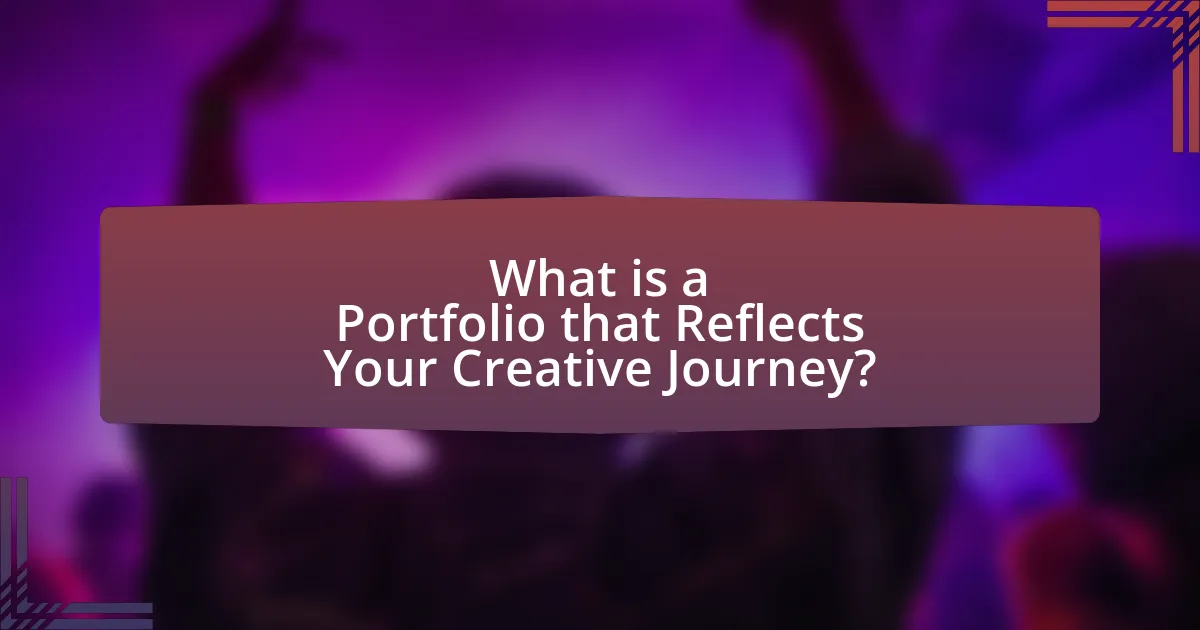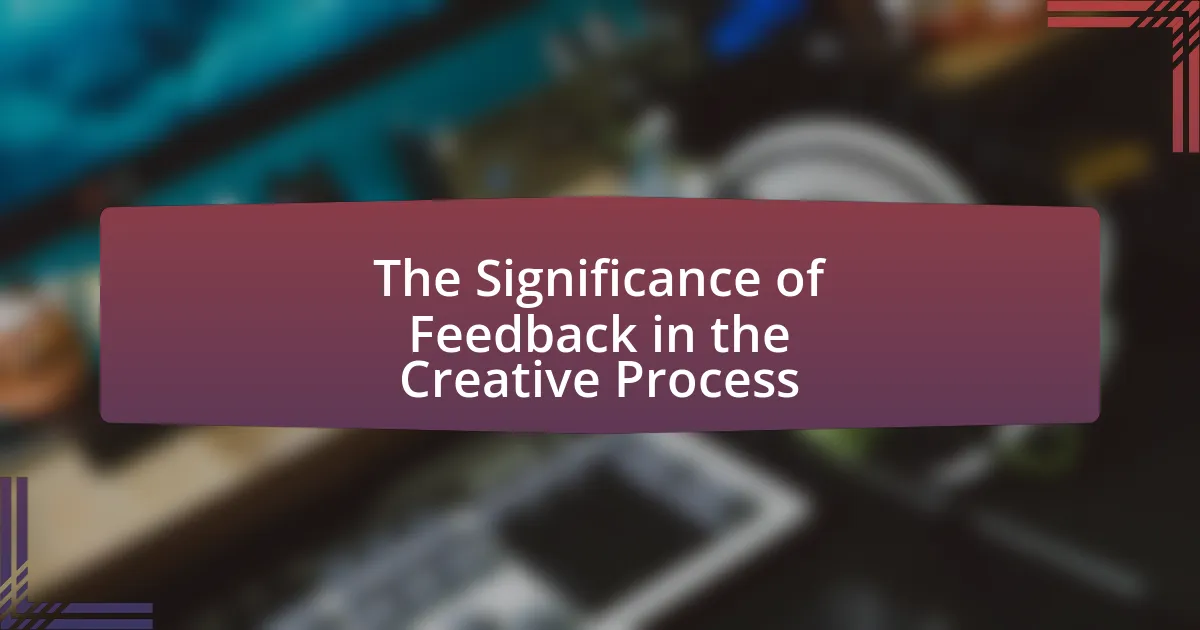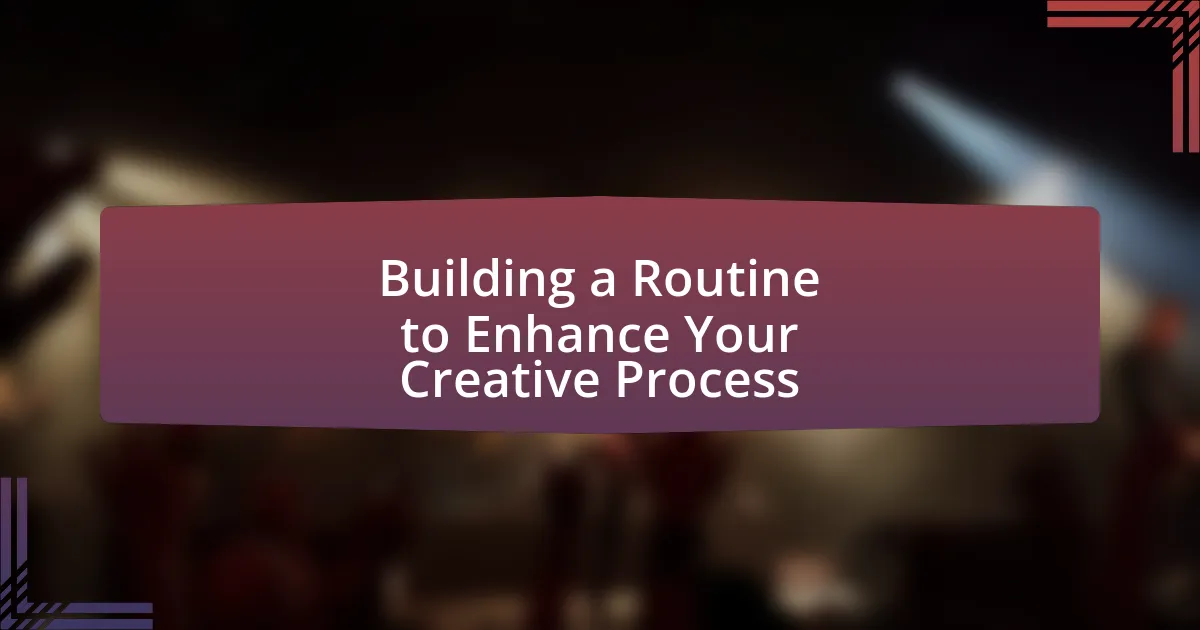A portfolio that reflects your creative journey is a curated collection showcasing an individual’s skills, experiences, and growth as a creator. This article outlines the differences between creative and traditional portfolios, emphasizing the importance of originality, diversity, and effective presentation. It discusses how personal experiences shape portfolio content, the significance of storytelling, and best practices for creating and maintaining a compelling portfolio. Additionally, it provides guidance on selecting the right platform and multimedia elements to enhance visibility and engagement, ensuring that the portfolio effectively communicates the creator’s unique artistic voice and journey.

What is a Portfolio that Reflects Your Creative Journey?
A portfolio that reflects your creative journey is a curated collection of your work that showcases your skills, experiences, and growth as a creative individual. This type of portfolio not only includes completed projects but also highlights the evolution of your style, techniques, and concepts over time. For instance, a graphic designer might include early sketches alongside final designs to illustrate their development. By presenting a narrative through the selection of works, the portfolio effectively communicates your unique artistic voice and the influences that have shaped your creative path.
How does a creative portfolio differ from a traditional portfolio?
A creative portfolio differs from a traditional portfolio primarily in its focus on showcasing artistic expression and unique projects rather than standardized qualifications and experiences. Creative portfolios emphasize visual elements, personal style, and innovative work, often including multimedia formats such as images, videos, and interactive content, while traditional portfolios typically present a structured collection of resumes, cover letters, and work samples that adhere to conventional formats. This distinction is evident in the way creative portfolios prioritize originality and personal branding, reflecting the creator’s individual journey and skills in a more dynamic and engaging manner.
What elements are essential in showcasing creativity?
Essential elements in showcasing creativity include originality, diversity, and presentation. Originality refers to the uniqueness of ideas and concepts, which can be demonstrated through innovative projects or distinct artistic styles. Diversity involves incorporating a range of mediums, techniques, and themes, showcasing versatility and adaptability in creative expression. Presentation is crucial as it affects how the work is perceived; effective use of layout, organization, and visual appeal can enhance the overall impact of the portfolio. These elements collectively contribute to a compelling representation of an individual’s creative journey.
How can personal experiences shape the content of a portfolio?
Personal experiences significantly shape the content of a portfolio by providing unique insights and narratives that reflect an individual’s journey and skills. These experiences inform the selection of projects, techniques, and themes showcased, allowing the portfolio to convey authenticity and personal growth. For instance, a designer who faced challenges in a specific project may highlight that work to demonstrate problem-solving abilities and resilience, making the portfolio more relatable and compelling to potential clients or employers. This connection between personal experiences and portfolio content enhances the storytelling aspect, making it a powerful tool for self-expression and professional representation.
Why is it important to reflect your creative journey in your portfolio?
Reflecting your creative journey in your portfolio is crucial because it showcases your growth, evolution, and unique perspective as an artist or creator. This reflection allows potential clients or employers to understand not only your skills but also the thought processes and experiences that have shaped your work. For instance, a study by the National Endowment for the Arts highlights that portfolios that narrate a personal journey tend to engage audiences more effectively, leading to higher chances of securing opportunities. By including projects that illustrate milestones, challenges, and breakthroughs, you provide context that enhances the value of your work and demonstrates your adaptability and commitment to your craft.
How does a reflective portfolio enhance personal branding?
A reflective portfolio enhances personal branding by showcasing an individual’s growth, skills, and unique experiences in a structured manner. This type of portfolio allows individuals to articulate their creative journey, demonstrating their thought processes, problem-solving abilities, and adaptability. By including reflections on past projects and experiences, individuals can highlight their learning outcomes and personal insights, which differentiate them from others in their field. Research indicates that personal branding is significantly influenced by the ability to convey authenticity and self-awareness, both of which are effectively communicated through a reflective portfolio.
What role does storytelling play in a creative portfolio?
Storytelling plays a crucial role in a creative portfolio by providing context and emotional resonance to the showcased work. It allows the creator to convey their unique journey, motivations, and the thought processes behind each piece, making the portfolio more engaging and memorable. Research indicates that narratives can enhance memory retention and emotional connection; for instance, a study published in the journal “Cognitive Science” found that stories are more effective than facts alone in influencing audience perception and recall. By integrating storytelling, a creative portfolio not only displays skills but also invites viewers to connect with the creator on a deeper level, ultimately enhancing the impact of the work presented.

How to Start Creating Your Creative Portfolio?
To start creating your creative portfolio, first identify your target audience and the purpose of your portfolio. This foundational step ensures that the content and presentation align with the expectations of potential clients or employers. Next, curate a selection of your best work that showcases your skills and versatility; research indicates that portfolios with 10-15 high-quality pieces are most effective in demonstrating capability (source: “The Importance of Portfolios in Creative Careers,” Journal of Creative Studies, 2021). Finally, choose a platform for presentation, whether digital or physical, that enhances the visibility of your work and reflects your personal brand.
What steps should you take to gather your creative work?
To gather your creative work, first, compile all your projects, including sketches, designs, writings, and any other relevant materials. Organize these items by category or medium to create a structured overview of your work. Next, select your best pieces that showcase your skills and creativity, ensuring they align with the narrative you want to present in your portfolio. Finally, digitize your work if necessary, using high-quality images or scans, and create a cohesive layout that highlights your artistic journey. This methodical approach ensures that your portfolio effectively represents your creative evolution and capabilities.
How do you select pieces that best represent your journey?
To select pieces that best represent your journey, identify works that showcase your growth, skills, and unique perspective. This involves reflecting on your experiences and choosing pieces that highlight significant milestones or transformations in your creative process. For instance, if you have evolved in your artistic style, include earlier works that demonstrate your starting point alongside recent pieces that illustrate your current capabilities. This method not only provides a narrative of your development but also allows viewers to understand the context behind your creative evolution.
What criteria should you use to evaluate your work for inclusion?
To evaluate your work for inclusion in a portfolio, you should use criteria such as relevance, quality, diversity, and impact. Relevance ensures that the work aligns with the goals and themes of your creative journey, while quality assesses the technical and artistic standards of the pieces. Diversity highlights the range of skills and styles you possess, showcasing your versatility. Impact measures how effectively the work communicates your message or resonates with the audience. These criteria are essential for creating a cohesive and compelling portfolio that accurately reflects your creative journey.
How can you organize your portfolio effectively?
To organize your portfolio effectively, categorize your work by themes or projects to create a coherent narrative. This approach allows viewers to easily navigate through your skills and experiences, enhancing their understanding of your creative journey. For instance, grouping similar projects together can highlight your expertise in specific areas, such as graphic design or photography, making it easier for potential clients or employers to assess your capabilities. Additionally, maintaining a consistent layout and design across your portfolio reinforces your personal brand and professionalism, which is crucial in creative fields.
What are the best practices for structuring a creative portfolio?
The best practices for structuring a creative portfolio include organizing work by theme or medium, showcasing a diverse range of skills, and providing context for each piece. Organizing work thematically allows viewers to easily navigate and understand the artist’s focus, while showcasing a variety of skills demonstrates versatility and adaptability. Providing context, such as project descriptions or the creative process, enhances the viewer’s appreciation and understanding of the work. According to a study by the Creative Industries Federation, portfolios that effectively communicate the artist’s journey and thought process are more likely to engage potential clients and employers.
How can you create a cohesive narrative throughout your portfolio?
To create a cohesive narrative throughout your portfolio, you should establish a clear theme that reflects your personal style and journey. This involves selecting works that not only showcase your skills but also tell a story about your development as a creator. For instance, grouping projects by similar techniques or concepts can illustrate your growth and thought process over time. Additionally, including a consistent visual style, such as color schemes or typography, reinforces the narrative. Research indicates that portfolios with a strong narrative structure are more engaging and memorable, as they help viewers connect emotionally with the creator’s journey.

What Tools and Platforms Can You Use to Build Your Portfolio?
To build your portfolio, you can use tools and platforms such as Adobe Portfolio, Behance, Wix, Squarespace, and WordPress. Adobe Portfolio allows users to create customizable portfolio websites integrated with Adobe Creative Cloud, making it ideal for creatives. Behance serves as a social network for showcasing and discovering creative work, providing exposure to a wider audience. Wix and Squarespace offer user-friendly website builders with templates specifically designed for portfolios, enabling easy customization without coding skills. WordPress, a versatile content management system, allows for extensive customization and is suitable for those who want more control over their portfolio’s design and functionality. Each of these platforms has been widely adopted by professionals in various creative fields, demonstrating their effectiveness in portfolio creation.
What digital platforms are best for showcasing creative work?
The best digital platforms for showcasing creative work include Behance, Dribbble, and Instagram. Behance is widely recognized for its professional portfolio capabilities, allowing creatives to display projects and connect with industry professionals. Dribbble serves as a community for designers to share their work and receive feedback, making it ideal for visual artists. Instagram, with its vast user base, offers a visually-driven platform where creatives can reach a broader audience and engage with followers through images and videos. These platforms are effective due to their specific features tailored for creative professionals, such as networking opportunities, community engagement, and visual storytelling capabilities.
How do you choose the right platform based on your creative field?
To choose the right platform based on your creative field, first identify the specific needs and characteristics of your discipline, such as visual appeal for artists or functionality for writers. For instance, platforms like Behance or Dribbble cater specifically to visual artists, offering features that highlight portfolios effectively, while Medium is tailored for writers, providing a clean interface for text-based content. Research indicates that 70% of creative professionals find specialized platforms more beneficial for showcasing their work, as they attract targeted audiences and enhance networking opportunities. Therefore, aligning your choice with the unique demands of your creative field ensures optimal visibility and engagement.
What features should you look for in a portfolio website?
A portfolio website should include a clean and intuitive design, showcasing your work effectively. Essential features include high-quality images or videos of your projects, a clear navigation menu, an about section detailing your background, and contact information for potential clients or collaborators. Additionally, integrating a blog or case studies can provide context to your work, while responsive design ensures accessibility across devices. Statistics show that 94% of first impressions relate to web design, emphasizing the importance of a professional appearance.
How can you incorporate multimedia elements into your portfolio?
To incorporate multimedia elements into your portfolio, include a variety of formats such as images, videos, audio clips, and interactive content. Utilizing high-quality images of your work can visually engage viewers, while videos can showcase your process or final products in action, enhancing understanding. Audio clips can provide context or commentary, adding a personal touch. Interactive elements, like clickable prototypes or animations, can demonstrate your skills in a dynamic way. Research indicates that portfolios featuring multimedia elements can increase viewer engagement by up to 80%, making your work more memorable and impactful.
What types of multimedia can enhance your portfolio presentation?
Visual elements such as images, videos, and infographics can significantly enhance your portfolio presentation. Images showcase your work visually, allowing potential clients or employers to quickly grasp your style and capabilities. Videos can provide dynamic demonstrations of your projects, offering insights into your process and the final product. Infographics can effectively summarize complex information, making it easier for viewers to understand your skills and achievements at a glance. Incorporating these multimedia types not only engages the audience but also creates a more memorable and impactful presentation of your creative journey.
How do you ensure multimedia elements align with your creative narrative?
To ensure multimedia elements align with a creative narrative, I meticulously select visuals, audio, and text that complement and enhance the story being told. This alignment is achieved by establishing a clear thematic framework that guides the choice of each multimedia component, ensuring they collectively support the intended message. For instance, using color palettes and imagery that evoke specific emotions can reinforce the narrative’s tone, while sound design can heighten engagement and immersion. Research indicates that cohesive multimedia presentations can increase audience retention by up to 65%, demonstrating the effectiveness of this approach in creating a unified and impactful portfolio.

What are the Best Practices for Maintaining Your Creative Portfolio?
The best practices for maintaining your creative portfolio include regularly updating your work, curating content to reflect your current skills and interests, and ensuring a cohesive presentation. Regular updates keep your portfolio relevant and showcase your growth, while curation helps highlight your best pieces, making it easier for viewers to understand your style and expertise. A cohesive presentation, including consistent formatting and branding, enhances professionalism and makes a strong impression on potential clients or employers.
How often should you update your portfolio?
You should update your portfolio at least every six months. Regular updates ensure that your portfolio reflects your most current skills, projects, and experiences, which is crucial in a rapidly changing creative landscape. According to a survey by the Creative Group, 70% of hiring managers prefer candidates whose portfolios showcase recent work, emphasizing the importance of keeping your portfolio relevant and up-to-date.
What indicators suggest it’s time for an update?
Indicators that suggest it’s time for an update include significant changes in personal skills, shifts in industry trends, and the introduction of new projects or works. When an individual acquires new skills or techniques that enhance their creative output, it is essential to reflect these advancements in their portfolio. Additionally, if industry standards evolve, such as new design trends or technological advancements, updating the portfolio ensures relevance. Lastly, the completion of new projects or the development of a unique style warrants an update to showcase the latest work and maintain an accurate representation of the creator’s journey.
How can feedback influence your portfolio updates?
Feedback can significantly influence portfolio updates by providing insights into strengths and weaknesses in the work presented. Constructive criticism from peers, mentors, or clients can highlight areas for improvement, guiding the selection of projects that best showcase skills and creativity. For instance, if multiple reviewers note that a particular style resonates well, an individual may choose to emphasize similar works in their portfolio. Additionally, feedback can reveal trends in audience preferences, allowing for strategic updates that align with market demands. This iterative process ensures that the portfolio remains relevant and reflective of the creator’s evolving artistic journey.
What common mistakes should you avoid when creating a portfolio?
When creating a portfolio, you should avoid common mistakes such as including too many pieces, which can dilute the impact of your best work. A focused selection of high-quality projects demonstrates your skills more effectively than a large quantity of mediocre work. Additionally, neglecting to tailor your portfolio to your target audience can lead to missed opportunities; understanding the preferences of potential clients or employers is crucial. Failing to update your portfolio regularly can also hinder your chances, as showcasing your most recent and relevant work keeps your presentation fresh and aligned with current trends. Lastly, overlooking the importance of presentation, such as layout and design, can detract from the overall impression; a well-organized and visually appealing portfolio enhances the viewer’s experience and reflects professionalism.
How can oversharing detract from your creative message?
Oversharing can detract from your creative message by overwhelming the audience with excessive information, which can dilute the core message. When creators provide too many details about their process or personal experiences, it can lead to confusion and disengagement, as the audience may struggle to identify the main theme or purpose of the work. Research indicates that concise communication enhances clarity and retention; for instance, a study published in the Journal of Communication found that audiences are more likely to remember key messages when they are presented succinctly. Therefore, maintaining focus on essential elements while avoiding oversharing is crucial for effectively conveying a creative message.
What pitfalls should you watch out for in design and layout?
In design and layout, common pitfalls include cluttered visuals, poor typography, and inconsistent branding. Cluttered visuals can overwhelm viewers, making it difficult to focus on key elements; studies show that clean designs improve user engagement by up to 60%. Poor typography can hinder readability, with research indicating that 38% of users will stop engaging with content if the layout is unattractive. Inconsistent branding can confuse the audience, leading to a lack of trust; a survey found that 75% of consumers recognize brands by their visual identity. Avoiding these pitfalls is essential for creating an effective portfolio that accurately reflects your creative journey.
What tips can help you create a standout creative portfolio?
To create a standout creative portfolio, focus on showcasing your best work, ensuring it reflects your unique style and skills. Curate a selection of projects that highlight your strengths and versatility, while maintaining a cohesive theme that aligns with your artistic vision. Use high-quality images and clear descriptions to provide context for each piece, demonstrating your thought process and the techniques employed. Additionally, consider including personal projects or collaborations that illustrate your passion and creativity. Research indicates that portfolios with a clear narrative and visual consistency are more engaging, as they help potential clients or employers understand your creative journey and capabilities.
How can you effectively showcase your unique style and voice?
To effectively showcase your unique style and voice, curate a portfolio that highlights your best work and reflects your personal aesthetic. This involves selecting pieces that not only demonstrate your skills but also convey your individual perspective and creative approach. For instance, if you are a graphic designer, include projects that utilize your preferred color palettes, typography, and design principles, ensuring that each piece tells a story about your artistic identity. Research indicates that a well-organized portfolio can increase the likelihood of attracting clients or job opportunities by up to 70%, as it allows viewers to quickly grasp your unique attributes and capabilities.
What strategies can you use to engage your audience through your portfolio?
To engage your audience through your portfolio, utilize interactive elements, storytelling, and visual appeal. Interactive elements, such as clickable prototypes or animations, allow viewers to experience your work actively, increasing engagement. Storytelling through project descriptions can create emotional connections, as narratives help audiences understand the context and thought process behind your creations. Additionally, employing a visually appealing layout with high-quality images and consistent branding captures attention and encourages exploration. Research indicates that portfolios with strong visual elements can increase viewer retention by up to 80%, demonstrating the effectiveness of these strategies in engaging audiences.





